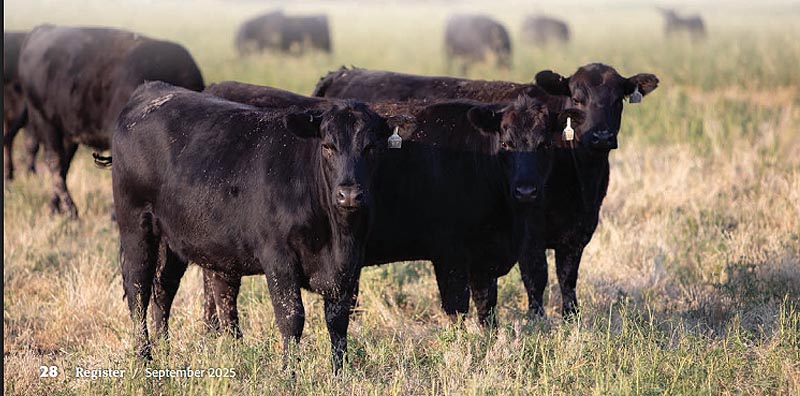by Sarah Phelps, Breeding and Genetics Graduate Student, and Dr. Randie Culbertson, Assistant Professor, Iowa State University
Moving heifers from the feedlot to pasture post-breeding season can cause pregnancy loss due to changes in diet, and subsequent weight loss. Preventing this weight loss is essential for maintaining heifer pregnancy.
For spring-born heifers, the majority of postweaning heifer development occurs during the winter months. In some regions of the United States, producers may opt to develop heifers in a drylot for more consistent and manageable conditions. Heifer development practices that utilize drylot feeding to increase average daily gain have been associated with a decrease in age at puberty. Heifers that reach puberty and are cyclical at the start of the breeding season have higher conception rates, compared to non-cyclical heifers. Additionally, early pubertal heifers that conceive have a longer postpartum recovery interval before rebreeding, which has been linked to higher pregnancy rates and lower pregnancy loss. Spring-calving heifers are bred in late spring or early summer, aligning with when pasture becomes available for many northern states. It is common for producers to turn heifers out onto pasture immediately after AI breeding to minimize labor efforts. Previous research has shown that a reduction in AI pregnancy can be experienced in heifers that initially lose weight due to transitioning from drylot to pasture management. However, diet changes,
without body condition loss, have not been shown to decrease pregnancy rates. Further research found that heifers that continued to gain weight under pasture management during the first 21 days of the breeding season had higher conception rates compared to heifers that lost weight during this period. These findings highlight the importance of carefully managing the transition of heifers from drylot to pasture management after AI breeding.
A recent heifer development study conducted at the Iowa State University McNay Memorial Research and Demonstration Farm compared the subsequent pregnancy rates of two groups of heifers developed to different percentages of mature body weights at breeding. At weaning in October 2023, heifers were divided into two groups: the restricted group, developed to 55% of their mature body weight at breeding, and the non-restricted group, developed to 65% of their mature body weight at breeding. Drought conditions during the summer of 2023 caused heifers in the restricted group to be developed on a lower energy diet in a larger pen area, rather than directly on pasture, until adequate pasture growth was

reached three weeks before AI breeding. Non-restricted heifers were developed in standard drylot conditions until breeding. Following AI breeding, all heifers were managed on pasture as one group.
Body weight and carcass ultrasound measurements were taken at AI breeding and at final pregnancy determination, which occurred 85 days following initial AI and 30 days post-bull removal. Changes in body weight and body composition measurements for ribeye area (REA), backfat (BFAT), rump fat (RUMP), and percent intramuscular fat (IMF) between initial AI breeding and final pregnancy determination is shown in Figure 1. On average, the non-restricted group lost body weight due to pasture management while the restricted group continued to gain weight. Both groups experienced condition loss for REA, BFAT, and RUMP. However, the non-restricted group experienced a more drastic decrease in average measurements for these traits. Interestingly, both groups continued to gain IMF on pasture management. No difference in final pregnancy rates (AI-bred and natural-servicebred) were found between the two groups. A higher percentage of heifers in the non-restricted group were bred by AI compared to the restricted group, but this difference
was not statistically significant. Both groups experienced pregnancy loss, with four losses in the restricted group and two losses in the non-restricted group. It is important to align heifer development practices with the actions and goals of a cow-calf herd. Heifers developed to a higher percentage of mature body weight at breeding could result in more AI pregnancies compared to those developed to a lower body weight. However, higher-body-weight heifers tended to lose body condition more drastically when transitioned abruptly to pasture management. Comparatively, the heifers developed to lower body weights at breeding continued to gain weight when on pasture. Stress during the first couple of months of gestation can compromise embryonic health and increase pregnancy loss. Heifers that are losing weight during the initiation of pregnancy can result in reduced pregnancy rates. Therefore, care should be taken when transitioning heifers from a drylot to pasture. Although pasture may provide adequate feed, the management change may result in weight loss for heifers developed in a drylot. This study illustrates the change in body composition and weight when developing heifers are transitioned to pasture. .




